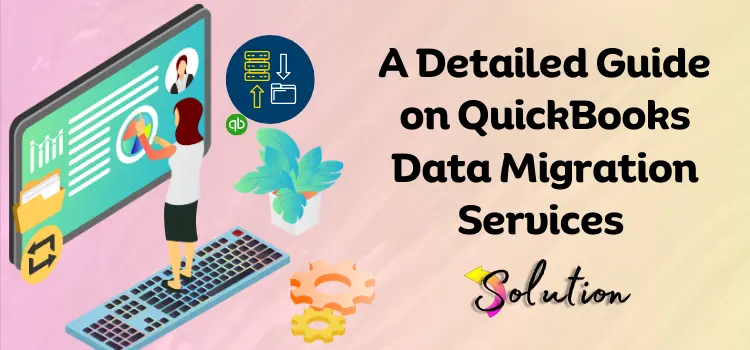
QuickBooks Data Migration Services are necessary in certain circumstances for a variety of reasons. However, many consumers are often perplexed by how data is transferred, why migration is required, and what processes are needed. To clear up any confusion, we’ve created a detailed tutorial that describes every step of the QuickBooks Data Migration procedure in simple terms.
This guide covers all you need to know about moving data from one QuickBooks edition or platform to another. Whether you’re migrating from QuickBooks Desktop to QuickBooks Online or transferring data from another accounting software like Sage or Xero, this guide will walk you through the process step by step.
Migrating data properly guarantees that your financial records, transactions, and customer information stay accurate and accessible, allowing your business to continue smoothly and without interruption. To help you plan properly, we will also highlight crucial items that are not transferable during the migration.
So, without wasting time, scroll down and read the comprehensive guide on QuickBooks Data Migration Services. By the end, you’ll have a thorough understanding of the procedure and the confidence to handle data migration effectively.
What are QuickBooks Data Migration Services?
Before beginning the QuickBooks Data Migration process, it is critical to understand what it entails. Simply explained, it means moving financial data, transactions, and settings from one QuickBooks edition or platform to another. This technique enables companies to migrate critical accounting data smoothly and securely, lowering the risk of data loss and downtime.
Migration services include transferring data from QuickBooks Desktop to QuickBooks Online, migrating records between QuickBooks versions or editions, and even transitioning from Sage or Xero to QuickBooks.
The purpose is to ensure that all financial records, client lists, and transaction histories are transferred correctly. However, some settings and data may not move automatically; thus, examining the process in advance is critical. With careful planning, businesses can assure a smooth transition and continue to manage their money efficiently without interruptions.
List of Things that Cannot Be Migrated in QB
It’s crucial to understand whether program constraints prevent data transfer before using QuickBooks Migration Services. Understanding these constraints in advance saves time and effort. We will not migrate payroll data, bank account information, audit logs, invoice templates, and third-party app integrations, among others. Check the entire list before beginning to guarantee a smooth transition.
- Company Preference & Settings: This data includes custom invoice templates and forms, sales tax settings, memorized reports, and payroll setup and preferences.
- Payroll & Employee Data: This type of data includes payroll transactions and paychecks, payroll tax forms, and filling or employee direct deposit information.
- Bank & Account Information: This includes credit card details and statements, bank account number, and recurring transactions, which must be recreated manually.
- Integrations & Third-party Apps: Data from connected third-party apps such as PayPal, Shopify, and customer add-ons and plugins.
- Reports & Audit Trail: Transaction history and audit log, budget and forecasting data, and reconciliations report.
- Other Miscellaneous Data: The multi-currency settings, customer chart of accounts numbering, attachments, and linked documents.
- Inventory & Lists Limitations: The inventory items include inventory assemblies, which are only basic inventory data that may transfer, and the price level and custom pricing rules.
Manual Process of Data Migration in QuickBooks
First, we discussed the manual QB Data Migration procedure. We suggest you carefully study and follow the procedures outlined below to prevent any glitches or data loss throughout the process. Let’s begin our journey:
Note: When considering a migration from QB Desktop to Online or from QB Online to Desktop, it is critical to back up your data on a regular basis. QB online stores your data on the Cloud server, eliminating the need for manual backups.
Step 1: Manually Backup Your Company Files
- Make sure you are not using multi-user mode.
- Now, on the QB desktop, navigate to the File menu.
- Click the Create Backup button and select Local Backup.
- Wait until the window appears, then click on Local Backup.
- Then, click the Next tab to proceed and select the Local Backup Only option.
- Select the Browser tab and search for the location where you want to save the company file.
- The automatic test will run to confirm that the backup procedure is running properly.
- Go through the troubleshooting issues section to see if any errors occurred.
- Click OK and then select the Save Now option.
- Then, open the Next tab.
- Wait until you receive a notification stating that the backup was installed correctly.
Note: Before proceeding to the next stage, it is critical to update your QuickBooks Desktop. If not, we recommend updating it first to avoid any issues during the process.
Step 2: Verify Total Target
The next stage is to determine the information linked to the overall targets. To achieve this, hit the Ctrl+1 or F2 keys, which will open the Product Information window in QB Desktop. The file information section offers information about the overall number of targets. You can only be eligible for a list and balance conversion if the objective numbers are as follows:
- For Canada, it’s 700,000.
- South Africa’s entire objective is 500,000.
- In the UK, the figure is 500,000.
Step 3: Save the Sales Tax Liability Report
- In QuickBooks Desktop, go to the Reports menu.
- Then select Suppliers and Payable.
- Choose the Sales Tax Liability option.
- Move your pointer to the drop-down section and select the All tab.
- In the Print list, scroll down and select the Save as PDF option.
- Click on the folder to which you wish to save the report.
- Name the folder as you choose and click the Save tab.
- Finally, save the file so that you can print a hard copy.
Step 4: Export the Reports and Lists
- To begin the procedure, navigate to the Reports option in QB Desktop.
- Click on the Report Center option.
- Search for any report to open, then select the necessary data range from the dates menu.
- Then, in the toolbar, click the Excel icon.
- Further, choose the Print or Email option to save the report as a PDF.
- From the drop-down, click on Excel and then on Create a new worksheet in a new Excel workbook.
- To update an existing workbook with the data from the open report, select Update Existing Worksheet.
- Select Export and locate the worksheet on the computer.
- Choose the advanced option if you wish to format the data in a certain way.
- If a notice displays indicating that the report has too many columns, click the Advanced Now option.
- Select and uncheck the space between columns checkbox, then click the OK tab.
- When the export is ready, click OK before migrating from Desktop to Online.
Step 5: Create a QB Online Account
Before proceeding to the fifth step, you must understand that you can only move the company file within 60 days after signing up for QuickBooks Online. So, your subscription should ensure that you are prepared to convert within that time limit.
To prepare for the migration operation, you must first create your QB online subscription. You can select a suitable plan from the options provided. Furthermore, you must confirm compatibility with the system before proceeding to guarantee you have everything you need for a smooth QuickBooks experience. Next, when requested to sign in, enter the same credentials you used to access your QuickBooks Desktop account. However, wait till you’ve established your QB online company.
Read Also:- How to Fix the QBCFMonitorService Not Running Error
How to Use the QB Migration Tool to Migrate the Data?
The QuickBooks Migration Tool is an alternative method for migrating your QuickBooks data. This program makes the procedure easier, resulting in a flawless transfer of your company files. We have developed extensive step-by-step instructions to help you with the relocation. Follow these procedures carefully to ensure that your data is moved safely and your accounting activities work properly.
- Open QuickBooks Desktop on your previous computer and select the File option.
- Click on Utilities and select Move QuickBooks to another computer, then follow the directions.
- Make a backup when requested. This file contains your company’s data, preferences, and settings.
- Transfer the backup file to a USB drive or cloud storage.
- Install QuickBooks on your new computer, then launch the Migration Tool.
- Restore the backup by selecting Open or Restore a Company and then selecting the backup file.
- Check your data for correct transmission.
End note!
QuickBooks Data Migration Services are critical to ensure a smooth transition of your financial data between different versions or platforms. A well-executed migration improves data accuracy, reduces downtime, and keeps your organization running smoothly. We hope that the processes and insights provided in this tutorial have made it simpler and easier for you. If you found this guide useful, we invite you to browse our other blogs for further QuickBooks tips and solutions. Don’t forget to look into our incredible QuickBooks services to help you streamline your accounting tasks seamlessly.


